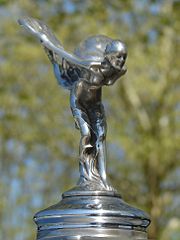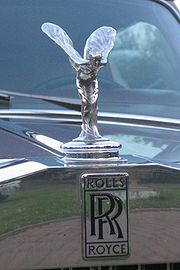
Spirit of Ecstasy
Encyclopedia


Hood ornament
A hood/bonnet ornament, or radiator cap, or car mascot is a specially crafted model of something which symbolizes a car company like a badge, located on the front center portion of the hood...
on Rolls-Royce
Rolls-Royce (car)
This a list of Rolls-Royce motor cars and includes vehicles produced by:*Rolls-Royce Limited *Rolls-Royce Motors , which was owned by Vickers between 1980 and 1998, and after that by Volkswagen...
cars
CARS
Cars, or automobiles, motor cars, are wheeled motor vehicles used for transporting passengers.Cars or CARS may also refer to:-Entertainment:* Cars , a Disney/Pixar film series...
. It is in the form of a woman leaning forwards with her arms outstretched behind and above her. Billowing cloth runs from her arms to her back, resembling wings.
Origins
The Spirit of Ecstasy, also called "Emily", "Silver Lady" or "Flying Lady", was designed by Charles Robinson SykesCharles Robinson Sykes
Charles Robinson Sykes was an English sculptor, better known for designing the Spirit of Ecstasy mascot which is used on Rolls-Royce cars...
and carries with it a story about a secret passion between John Walter Edward Douglas-Scott-Montagu, (second Lord Montagu of Beaulieu after 1905, a pioneer of the automobile movement, and editor of The Car Illustrated magazine from 1902) and his secret love and the model for the emblem, Eleanor Velasco Thornton. Eleanor was John Walter's secretary, and their love was to remain hidden, limited to their circle of friends, for more than a decade. The reason for the secrecy was Eleanor's impoverished social and economic status, which was an obstacle to their love. John-Walter, succumbing to family pressures, married Lady Cecil Victoria Constance, but the secret love affair continued.
Eleanor died on 30 December 1915, going down with the SS Persia, when the ship was torpedoed off Crete
Crete
Crete is the largest and most populous of the Greek islands, the fifth largest island in the Mediterranean Sea, and one of the thirteen administrative regions of Greece. It forms a significant part of the economy and cultural heritage of Greece while retaining its own local cultural traits...
by a German submarine, whilst she accompanied Lord Montagu on his journey to India, four years after she had been immortalized by her bereaved lover.
The Whisper
When Montagu commissioned his friend Sykes to sculpt a personal mascot for the bonnet of his Rolls-Royce Silver GhostRolls-Royce Silver Ghost
The Rolls-Royce Silver Ghost refers both to a car model and to one specific car from that series.Originally named the "40/50 h.p." the chassis was originally produced at Royce's Manchester works, before moving to Derby in July 1908 and also, between 1921 and 1926, in Springfield, Massachusetts....
, Sykes chose Eleanor Thornton as his model. Sykes originally crafted a figurine of her in fluttering robes, pressing a finger against her lips - to symbolise the secrets of their love. The figurine was consequently named The Whisper and is on display at the National Motor Museum, Beaulieu along with other Spirit of Ecstasy figurines.
The very first Rolls-Royce motorcars did not feature radiator mascots; they simply carried the Rolls-Royce emblem. This, however, was not enough for their customers who believed that such a prestigious vehicle as a Rolls-Royce motorcar should have its own luxurious mascot, and by 1910 personal mascots had become the fashion of the day. Rolls-Royce were concerned to note that some owners were affixing "inappropriate" ornaments to their cars. Claude Johnson, then managing director of Rolls-Royce Motor Cars, was asked to see to the commissioning of something more suitably dignified and graceful.
He turned to Charles Sykes, a young artist friend and a graduate of London's Royal College of Art, to produce a mascot which would adorn all future Rolls-Royce cars and become generic to the marque, with the specifications that it should convey "the spirit of the Rolls-Royce, namely, speed with silence, absence of vibration, the mysterious harnessing of great energy and a beautiful living organism of superb grace..."
The Spirit of Speed
Sykes' brief from Claude Johnson had been to evoke the spirit of mythical beauty, Nike
Nike (mythology)
In Greek mythology, Nike was a goddess who personified victory, also known as the Winged Goddess of Victory. The Roman equivalent was Victoria. Depending upon the time of various myths, she was described as the daughter of Pallas and Styx and the sister of Kratos , Bia , and Zelus...
, whose graceful image was admired in The Louvre, but Sykes was not impressed. He felt that a more feminine representation might be apt.
It was again Miss Thornton whom he had in mind. Sykes chose to modify ‘The Whisper’ into a version similar to today's; ‘The Spirit of Ecstasy’. He called this first model The Spirit of Speed. Later, Charles Sykes called it "A graceful little goddess, the Spirit of Ecstasy, who has selected road travel as her supreme delight and alighted on the prow of a Rolls-Royce motor car to revel in the freshness of the air and the musical sound of her fluttering draperies." He presented the mascot to the company in February 1911.
Some critics and fans of the Rolls Royce have given The Spirit of Ecstasy the dubious nickname "Ellie in her Nightie", suggesting Eleanor's influence as Sykes' muse.
Claude Johnson devised the description of The Spirit of Ecstasy, he described how Sykes had sought to convey the image of "the spirit of ecstasy, who has selected road travel as her supreme delight......she is expressing her keen enjoyment, with her arms outstretched and her sight fixed upon the distance."
Royce was ill during the commissioning of the flying lady. He did not believe the figurine enhanced the cars, asserting that it impaired the driver's view, and was rarely seen driving one of his company's vehicles adorned with the mascot.
Sykes' signature appeared on the plinth and were either signed "Charles Sykes, February 1911" or "Feb 6, 1911" or "6.2.11". Even after Rolls-Royce took over the casting of the figures in 1948 each Spirit of Ecstasy continued to receive this inscription until 1951.
The Spirit of Ecstasy was also manufactured by the British firm Louis Lejeune
Louis Lejeune
Louis Lejeune Ltd. is a small bronze foundry in England, producing mainly small ornamental bronzes, decorative architectural fittings, and car mascots...
for a number of years.
Alterations
Royce made sure it was officially listed as an optional extra, but in practice it was fitted on almost all cars after that year, becoming a standard fitting in the early 1920s. Automobiles change with the times, and the Spirit of Ecstasy was no exception. It was silverSilver
Silver is a metallic chemical element with the chemical symbol Ag and atomic number 47. A soft, white, lustrous transition metal, it has the highest electrical conductivity of any element and the highest thermal conductivity of any metal...
plated from 1911 until 1914 when the mascot was made with nickel
Nickel
Nickel is a chemical element with the chemical symbol Ni and atomic number 28. It is a silvery-white lustrous metal with a slight golden tinge. Nickel belongs to the transition metals and is hard and ductile...
or chrome
Chromium
Chromium is a chemical element which has the symbol Cr and atomic number 24. It is the first element in Group 6. It is a steely-gray, lustrous, hard metal that takes a high polish and has a high melting point. It is also odorless, tasteless, and malleable...
alloy to dissuade theft. The only departure from this came in Paris at the competition for the most apposite mascot of 1920, where a gold-plated version won first place. Gold
Gold
Gold is a chemical element with the symbol Au and an atomic number of 79. Gold is a dense, soft, shiny, malleable and ductile metal. Pure gold has a bright yellow color and luster traditionally considered attractive, which it maintains without oxidizing in air or water. Chemically, gold is a...
-plated versions were subsequently available at additional cost.
Although it seems unchanged, the mascot had eleven main variations in its life. Lowered height of coachwork forced subsequent reductions in the mascot size. Consequently, several alterations in the original design were made.
Sykes was once again commissioned by Rolls-Royce in the 1930s to make a lower version of the mascot to suit the sports saloons.
Kneeling version
The kneeling lady mascot was unveiled on 26 January 1934 (devised for the Phantom III of 1936-1939) and was as undeniably a reflection of Eleanor as it was a symbol of the Rolls-Royce. It also bore on the plynth the inscription "C. Sykes, 26.1.34", the date when the first piece was finished. This version was, however, discontinued after the Silver WraithRolls-Royce Silver Wraith
For information on the Silver Wraith II, see Rolls-Royce Silver Shadow.The Silver Wraith was the first post-war Rolls-Royce model and was made at the Crewe factory from 1946 to 1959....
, the Silver Dawn
Rolls-Royce Silver Dawn
The Rolls-Royce Silver Dawn is a car that was produced by Rolls-Royce at their Crewe works between 1949 and 1955. It was the first Rolls-Royce car to be offered with a factory built body which it shared, along with its chassis, with the Bentley Mark VI until 1952 and then the Bentley R Type until...
and Phantom IV
Rolls-Royce Phantom IV
The Phantom IV is the most exclusive Rolls-Royce model ever built.Only 18 were made between 1950 and 1956, exclusively for royalty and heads of state...
models, in favour of a smaller version of the original standing mascot, and so it remains to date.
The Flying Lady
In the United States the mascot is called The Flying Lady. The Flying Lady was a modified version of The Spirit of Ecstasy figurine to make it bow a little farther in order to protect the bonnet.Modern Spirit of Ecstasy
Today's Spirit of Ecstasy from the Silver Seraph (and the Corniche of the same bodystyle) model onward stands at 3 inches and, for safety, is mounted on a spring-loaded mechanism designed to retract instantly into the radiator shell if struck from any direction. There is a button within the vehicle which can retract/extend the emblem when pressed. She can be made of highly polished stainless steelStainless steel
In metallurgy, stainless steel, also known as inox steel or inox from French "inoxydable", is defined as a steel alloy with a minimum of 10.5 or 11% chromium content by mass....
, or stainless with a sterling silver plate or 24-carat gold plate, the sterling silver and gold being optional extras.
Curiosities
The only two Rolls-Royces this mascot does not appear on currently is the first Phantom IV delivered to the then Princess Elizabeth in 1950, which carries the British QueenQueen regnant
A queen regnant is a female monarch who reigns in her own right, in contrast to a queen consort, who is the wife of a reigning king. An empress regnant is a female monarch who reigns in her own right over an empire....
's mascot of St. George on horseback, slaying a dragon, designed by artist Edward Seago. However this mascot is interchangeable so it can be placed in any of the Royal fleet's cars.
On the other side, Princess Margaret chose Pegasus (by Louis Lejeune
Louis Lejeune
Louis Lejeune Ltd. is a small bronze foundry in England, producing mainly small ornamental bronzes, decorative architectural fittings, and car mascots...
) as hood ornament for her 1954 Phantom IV.

